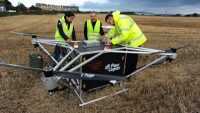Flowcopter is said to be creating the world’s first gas-fueled drone, with a flight range of hundreds of miles, potentially spanning hours. Current drones rely on battery power or electrical recharging. While the consensus is that battery technology is advancing rapidly, and will someday permit lightweight, long-range travel in drones and other vehicles, fossil fuels currently provide denser sources of energy with less weight and at lower cost. The reasons there are no gas-fueled quadcopters to date is their engines aren’t as precisely controllable as are electric motors. But Flowcopter feels it has overcome that.
The ability to “immediately and accurately adjust the rotation speed of each rotor on a quadcopter is essential to stable and controllable flight,” reports Gizmodo, explaining that lack of precise control “isn’t an issue on a plane where a propellor or jet engine’s only job is to provide thrust in one direction, but on a quadcopter, each spinning blade needs to be constantly adjusted to counter unending wind gusts and avoid the endless pull of gravity.”

While some companies — like Chevrolet, for its Volt — use gas engines to power generators that supply power to electric motors, the Edinburgh-based Flowcopter is taking a different approach. “Its heavy-lift cargo drones will run aviation-certified combustion engines, and these engines will drive Digital Displacement pumps repurposed from the off-road and industrial vehicle markets, to run hydraulic motors at the props,” writes New Atlas.
“These pumps are able to distribute and regulate hydraulic flow between a number of different outputs, under digital control, with the kinds of near-instant response times you need to balance a drone in flight. Each hydraulic motor will deliver up to an enormous 96 kW (129 hp) of power, while weighing just 5.5 kg (12 lb) and costing less than $1,000 apiece. Flowcopter says ‘nothing electric comes even close.’”
Flowcopter calls its invention “the worlds first hydraulic hybrid multicopter.” It claims its drone “could stay in the air without refueling (or occasionally switching to non-powered gliding flight like a traditional winged aircraft can) for up to six hours and cross distances up to 900 kilometers,” or 559 miles, Gizmodo says. “Shorter flights could facilitate payloads up to 330 pounds, making the drone a more capable short-range autonomous delivery vehicle that doesn’t have to deal with traffic or lengthy charge times between flights.”

No Comments Yet
You can be the first to comment!
Sorry, comments for this entry are closed at this time.